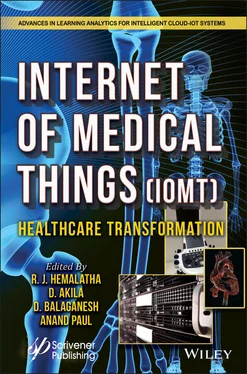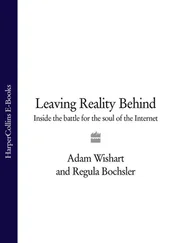The Internet of Medical Things (IoMT)
Здесь есть возможность читать онлайн «The Internet of Medical Things (IoMT)» — ознакомительный отрывок электронной книги совершенно бесплатно, а после прочтения отрывка купить полную версию. В некоторых случаях можно слушать аудио, скачать через торрент в формате fb2 и присутствует краткое содержание. Жанр: unrecognised, на английском языке. Описание произведения, (предисловие) а так же отзывы посетителей доступны на портале библиотеки ЛибКат.
- Название:The Internet of Medical Things (IoMT)
- Автор:
- Жанр:
- Год:неизвестен
- ISBN:нет данных
- Рейтинг книги:3 / 5. Голосов: 1
-
Избранное:Добавить в избранное
- Отзывы:
-
Ваша оценка:
- 60
- 1
- 2
- 3
- 4
- 5
The Internet of Medical Things (IoMT): краткое содержание, описание и аннотация
Предлагаем к чтению аннотацию, описание, краткое содержание или предисловие (зависит от того, что написал сам автор книги «The Internet of Medical Things (IoMT)»). Если вы не нашли необходимую информацию о книге — напишите в комментариях, мы постараемся отыскать её.
Providing an essential addition to the reference material available in the field of IoMT, this timely publication covers a range of applied research on healthcare, biomedical data mining, and the security and privacy of health records.
The Internet of Medical Things (IoMT) — читать онлайн ознакомительный отрывок
Ниже представлен текст книги, разбитый по страницам. Система сохранения места последней прочитанной страницы, позволяет с удобством читать онлайн бесплатно книгу «The Internet of Medical Things (IoMT)», без необходимости каждый раз заново искать на чём Вы остановились. Поставьте закладку, и сможете в любой момент перейти на страницу, на которой закончили чтение.
Интервал:
Закладка:
References
1. Cancer Research UK, Worldwide cancer statistics , 2012, https://www.cancerresearchuk.org/health-professional/cancer-statistics/worldwide-cancer#collapseZero.
2. American Cancer Society, Lung cancer prevention and early detection , 2016, https://www.cancer.org/cancer/lung-cancer/prevention-and-early-detection/signs-and-symptoms.html.
3. American Cancer Society, Causes, risk factors and prevention , 2016, https://www.cancer.org/cancer/non-small-cell-lung-cancer/causes-risks-prevention/what causes.
4. Mayo Clinic, Lung cancer , 2018, https://www.mayoclinic.org/diseases-conditions/lung-cancer/diagnosis-treatment/drc-20374627.
5. El-Telbany, A. and Patrick, C.M., Cancer genes in lung cancer. Genes Cancer , M3, 7–8, 467–480, 2012.
6. Santos, D.C., Sheperd, F.A., Tsao, M.S., EGFR mutations and lung cancer. Annu. Rev. Pathol.: Mechanisms of Disease , 6, 49–69, 2016.
7. Bhattacharya, S., Socinski, M.A., T.F., KRAS mutant lung cancer: progress thus far on an elusive therapeutic target. Clin. Transl. Med ., 4, 35, 2015.
8. Halverson, A.R., Silwal-Pandit, L., Meza-Zepeda, L.A. et al ., TP53 mutation spectrum in smokers and never smoking lung cancer patients. Front. Genet ., 7, 85, 2016.
9. Basnet, P. and Skalko-Basnet, N., Curcumin: An anti-inflammatory molecule from a curry spice on the path to cancer treatment. Molecules , 6, 6, 4567–4598, 2011.
10. Healthline, Whyellagic acid is important?, 2020, https://www.healthline.com/health/ellagic-acid.
11. Kuo, P.-C., Liu, H.-F., Chao, J.-I., Survivin and p53 modulate quercetin-induced cell growth inhibition and apoptosis in human lung carcinoma cells. J. Biol. Chem ., 279, 53, 55875–55885, 2004.
12. Biasini, M., Bienert, S., Waterhouse, A., Arnold, K., Studer, G., Schmidt, T. et al ., SWISS-MODEL: Modelling protein tertiary and quaternary structure using evolutionary information. Nucleic Acids Res ., 42, W252-8, 2014.
13. Delano, W.L., The PyMOL molecular graphics system, 2001, http://www.pymol.org.
14. Gasteiger, E., Hoogland, C., Gattiker, A. et al ., Protein identification and analysis tools on the ExPASy server, in: The proteomics protocols handbook , J.M. Walker (Ed.), Humana Press, Totowa, 2015.
15. Prabi, L.G., Color protein sequence analysis, 1998, https://npsaprabi.ibcp.fr/cgi-bin/npsa_automat.pl?page=/NPSA/npsa_color.html.
16. Costantini, S., Colonna, G., Facchiano, A.M., ESBRI: a web server for evaluating salt bridges in proteins. Bioinformation , 3, 137–138, 2008.
17. Roy, S., Maheshwari, N., Chauhan, R. et al ., Structure prediction and functional characterization of secondary metabolite proteins of Ocimum. Bioinformation , 6, 8, 315–319, 2011.
18. Geourjon, C. and Deleage, G., SOPMA: significant improvements in protein secondary structure prediction by consensus prediction from multiple alignments. Comput. Appl. Biosci ., 11, 681–684, 1995.
19. Laskowski, R.A., MacArthur, M.W., Moss, D.S. et al ., PROCHECK: a program to check the stereo chemical quality of protein structures. J. Appl. Cryst ., 26, 283–291, 1993.
20. Wallner, B. and Elofsson, A., Can correct protein models be identified? Protein Sci ., 12, 1073–1086, 2003.
21. Colovos, C. and Yeates, T.O., Verification of protein structures: patterns of non-bonded atomic interactions. Protein Sci ., 2, 1511–1519, 1993.
22. Eisenberg, D., Luthy, R., Bowie, J.U., VERIFY3D: assessment of protein models with three- dimensional profiles. Methods Enzymol ., 77, 396–404, 1977.
23. Jayaram, B., Active site prediction server, 2004, http://www.scftio-iitd.res.in/dock/ActiveSite.jsp.
24. National Center for Biotechnology Information, Pubchem., 2017, https://pubchem.ncbi.nlm.nih.gov/.
25. Hui, S.L. and Yang, Z., BSP-SLIM: A blind low-resolution ligand-protein docking approach using theoretically predicted protein structures. Proteins , 80, 93–110, 2012.
26. Kumar, S., Tsai, C.J., Ma, B. et al ., Contribution of salt bridges toward protein thermo-stability. J. Biomol. Struct. Dyn ., 1, 79–86, 2000.
27. Kumar, S. and Nussinov, R., Salt bridge stability in monomeric proteins. J. Mol. Biol ., 293, 1241–1255, 2009.
28. Kumar, S. and Nussinov, R., Relationship between ion pair geometries and electrostatic strengths in proteins. Biophys. J ., 83, 1595–1612, 2002.
29. Parvizpour, S., Shamsir, M.S., Razmara, J. et al ., Structural and functional analysis of a novel psychrophilic b-mannanase from Glaciozyma Antarctica PI12. J. Comput. Aided Mol. Des ., 28, 6, 685–698, 2014.
30. Murugesan, D., Ponnusamy, R.D., Gopalan, D.K., Molecular docking study of active phytocompounds from the methanolic leaf extract of vitexnegundo- against cyclooxygenase-2. Bangladesh J. Pharmacol ., 9, 2, 146–53, 2014.
31. Balamurugan, V and Balakrishnan, V., Molecular docking studies of Moringaconcanensis nimmo leaf phytocompounds for brain cancer. Res. Rev.: J. Life Sci ., 8, 1, 26–34, 2018.
32. Santhanakrishnan, D., Sipriya, N., Chandrasekaran, B., Studies on the phytochemistry, spectroscopic characterization and antibacterial efficacy of Salicornia Brachiata. Int. J. Pharm. Pharm. Sci ., 6, 6430–6432, 2014.
33. Kasilingam, T. and Elengoe, A., In silico molecular modeling and docking of apigenin against the lung cancer cell proteins. Asian J. Pharm. Clin. Res ., 11, 9, 246–252, 2018.
34. Ashwini, S., Varkey, S.P., Shantaram, M., Insilico docking of polyphenolic compounds against Caspase 3-HeLa cell line protein. Int. J. Drug Dev. Res ., 9, 28–32, 2017.
35. Chakrabarty, N., Hossain, A., Barua, J., Kar, H., Akther, S., Al Mahabub, A., Majumder, M., Insilico molecular docking of some isolated selected compounds of lantana camera against Alzheimer’s disease. Biomed. J. Sci. Tech. Res ., 12, 2, 9168–9171, 2018.
36. Supramaniam, G. and Elengoe, A., In silico molecular docking of glycyrrhizin and breast cancer cell line proteins, in: Plant-Derived Bioactives , 1, 575–589, 2020.
37. Elengoe, A. and Sebestian, E., In silico molecular modelling and docking of allicin, epigallocatechin-3-gallate and gingerol against colon cancer cell proteins. Asia Pac. J. Mol. Biol. Biotechnol ., 4, 2851–67, 2020.
1 *Corresponding author: asitaelengoe@yahoo.com
2
Medical Data Classification in Cloud Computing Using Soft Computing With Voting Classifier: A Review
Saurabh Sharma1*, Harish K. Shakya1† and Ashish Mishra2‡
1Dept. of CSE, Amity School of Engineering & Technology, Amity University (M.P.), Gwalior, India
2Department of CSE, Gyan Ganga Institute of Technology and Sciences, Jabalpur, India
Abstract
In the current context, a tele-medical system is the rising medical service where health professionals can use telecommunication technology to treat, evaluate, and diagnose a patient. The data in the healthcare system signifies a set of medical data that is sophisticated and larger in number (X-ray, fMRI data, scans of the lungs, brain, etc.). It is impossible to use typical hardware and software to manage medical data collections. Therefore, a practical approach to the equilibrium of privacy protection and data exchange is required. To address these questions, several approaches are established, most of the studies focusing on only a tiny problem with a single notion. This review paper analyzes the data protection research carried out in cloud computing systems and also looks at the major difficulties that conventional solutions confront. This approach helps researchers to better address existing issues in protecting the privacy of medical data in the cloud system.
Читать дальшеИнтервал:
Закладка:
Похожие книги на «The Internet of Medical Things (IoMT)»
Представляем Вашему вниманию похожие книги на «The Internet of Medical Things (IoMT)» списком для выбора. Мы отобрали схожую по названию и смыслу литературу в надежде предоставить читателям больше вариантов отыскать новые, интересные, ещё непрочитанные произведения.
Обсуждение, отзывы о книге «The Internet of Medical Things (IoMT)» и просто собственные мнения читателей. Оставьте ваши комментарии, напишите, что Вы думаете о произведении, его смысле или главных героях. Укажите что конкретно понравилось, а что нет, и почему Вы так считаете.












